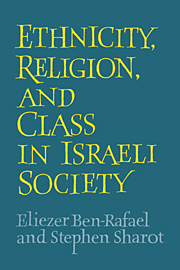Book contents
- Frontmatter
- Contents
- Acknowledgments
- I Theoretical and empirical background
- II Social patterns and behavior
- III Identities and images
- 8 Ethnic consciousness
- 9 Class consciousness
- 10 Religious, ethnic, and class divisions: convergent or crosscutting?
- IV The impact of stratification
- V Social cleavages: an overview of Israeli society and some theoretical implications
- Appendix A The sample
- Appendix B Deprivation index
- Appendix C Indexes of ethnic identification
- Glossary
- Notes
- References
- Index
9 - Class consciousness
Published online by Cambridge University Press: 12 September 2009
- Frontmatter
- Contents
- Acknowledgments
- I Theoretical and empirical background
- II Social patterns and behavior
- III Identities and images
- 8 Ethnic consciousness
- 9 Class consciousness
- 10 Religious, ethnic, and class divisions: convergent or crosscutting?
- IV The impact of stratification
- V Social cleavages: an overview of Israeli society and some theoretical implications
- Appendix A The sample
- Appendix B Deprivation index
- Appendix C Indexes of ethnic identification
- Glossary
- Notes
- References
- Index
Summary
Israel's “exceptionalism”
There are a few studies of the historical development of the class structure in Israel (Rosenfeld and Carmi, 1976; Shapiro, 1977; Ben-Porat, 1986,1989), but discussions of class consciousness or conflict have rarely been part of the discourse on stratification and inequality in the sociology of Israel (partial exceptions are Yatziv, 1979; Ben-Porat, 1985). Attention has focused on the “ethnic gap” between Ashkenazim and edot ha'Mizrach and disputes among Israeli sociologists have mainly revolved around explanations of this gap (Smooha, 1978; Swirski, 1981; Smooha and Peres, 1975; Hartman and Ayalon, 1975). Marxist analyses have made references to class conflict within Israel, but this theme has been subordinated to, or conflated with, ethnic conflict either within the Jewish population or between Jews and Arabs. The relative absence of class consciousness, which is assumed rather than demonstrated, is explained by nationalism, the centrality of ethnicity, and the uniqueness of the Israeli version of capitalism in the form of co-operation between the private sector and the bureaucracy of the Labor sector (Machover and Orr, 1971; Zureik, 1979). The author of a recent neo-Marxist work on class structure in Israel from 1948 to the 1980s states that, although the emerging capitalist system in Israeli society has inevitably produced classes “in themselves,” there has been no development of classes “for themselves.”
- Type
- Chapter
- Information
- Ethnicity, Religion and Class in Israeli Society , pp. 136 - 154Publisher: Cambridge University PressPrint publication year: 1991

